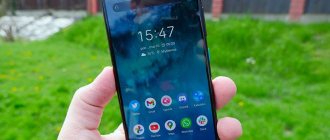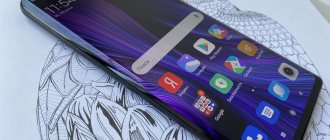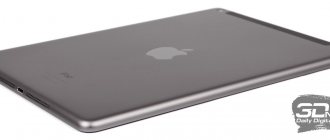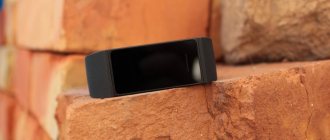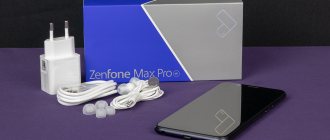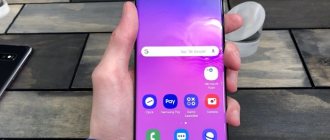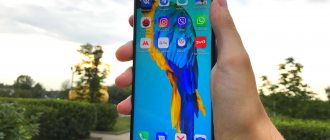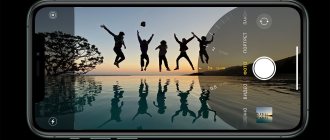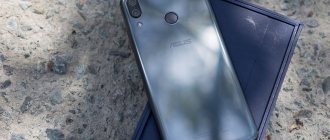Although ASUS' Zenfone line has been around for many years, it has never been hugely popular. Many people don’t even know about its existence, but the ASUS Zenfone 8 smartphone is worth paying attention to.
This time, ASUS focused on combining a compact design with powerful hardware and high battery life. And the manufacturer succeeded. Although prices for the new Zenfone 8 start at 50 thousand rubles, the smartphone really seems like a good option for purchase.
Specifications ASUS Zenfone 8
| Screen | 5.92" AMOLED, 2400x1080 resolution (20:9, 446 ppi), 82.9% bezel occupancy, 700 nits brightness (typical), 1100 nits maximum, 120 Hz refresh rate, 240 Hz touch panel refresh rate , HDR10+ |
| CPU | Snapdragon 888 (5nm), cores: 1×Kryo 680 (2.84 GHz), 3×Kryo 680 (2.42 GHz), 4×Kryo 680 (1.8 GHz) |
| Graphic arts | Adreno 660 |
| RAM | 6/8/16 GB |
| Inner memory | 128/256 GB UFS 3.1 |
| System and software | Android 11, ZenUI 8 |
| Main cameras | 64 MP, main, f/1.8, Sony IMX686 (PDAF, OIS) + 12 MP, ultra-wide angle, f/2.2, Sony IMX363 (PDAF) |
| Front camera | 12 MP, f/2.45, Sony IMX663 |
| Networks | Dual SIM: 5G/4G/3G/2G |
| Connection and communication | Wi-Fi 802.11a/b/g/n/ac/ax, Bluetooth 5.2 (aptX, aptX HD, LDAC, AAC), NFC |
| Navigation | GPS (dual band), BeiDou, GLONASS, Galileo (dual band) |
| Waterproof | IP68 |
| Battery | 4000 mAh with fast charging up to 30 W (USB Power Delivery 3.0) |
| Additionally | 3.5 mm audio jack, under-display fingerprint scanner |
| Dimensions and weight | 148 x 68.5 x 8.9 mm 169 grams |
| Materials | Front Gorilla Glass Victus, aluminum body, rear Gorilla Glass 3 |
| Color options | Obsidian Black (black), Horizon Silver (silver) |
| Price | From 50 thousand rubles |
Hot Power
Everything inside is at the top level: it’s a fast but hot Qualcomm Snapdragon 888. Under load, the smartphone gets very hot, and it becomes so hot that it’s unpleasant to hold it. It feels like 50 degrees. The cooling system developed by ASUS doesn’t help either - the chipset is distinguished by increased heat generation, judging by other tested phones with the same characteristics.
Therefore, if you plan to play very actively on your smartphone, then be prepared to wear gloves or figure out how to cool the ardent heart of the phone. In other cases, when it comes to shooting videos, processing photos, or watching videos on YouTube, nothing like this was noticed.
We sell the smartphone in two versions: 8/128 GB or 16/256 GB of memory. Other features include 5G support, two SIM card slots and the absence of a memory card tray.
Illustration: Svetlana Chuvileva / Wylsacom Media
Among the inconspicuous but useful characteristics, I would like to note the built-in function for recording telephone conversations. There is also a light indicator that is rare these days - however, it is located in an unusual place, on the bottom end.
The capabilities of the power button are also impressive: you can assign two additional actions to it. Accordingly, by double pressing or holding the key, you can launch applications or certain actions. For example, you can turn off data transfer or start Internet distribution.
I would like to write about sound in more detail than usual. Let's say that a pair of speakers can now be found in every flagship. But here it is loud, and clean, and pleasant. But a 3.5 mm jack is already a rarity in a top-end phone. On the one hand, wireless headphones are simply convenient. On the other hand, not all people are ready to sacrifice audio quality. So for music lovers, the little ASUS is just a godsend. Moreover, via Bluetooth with sound everything is also normal, there is support for all codecs, including LDAC.
Unpacking and packaging
The ASUS Zenfone 8 smartphone comes in a classic gray box containing traditional accessories, including a SIM card tray tool and documentation. The modular charger is adapted to today's fast standards, with a power of 30 W, to which we connect a USB-C to USB-C cable.
Another element of the set is a case with an unusual structure. The protector is made of plastic with a special texture that improves grip. The accessory does a good job of protecting the protruding camera and minimally protecting the front, although the edges remain exposed.
⇡#Communications and wireless communications
Both ASUS Zenfone 8 have a 5G modem, but without mmWave support. However, as far as the ranges and availability of technology in Russia are concerned, everything is written in stone in any case, so I won’t go into details. There is progress in LTE relative to Zenfone 7 Pro: the modem works with networks up to category 20 with a theoretical download speed of 2.0 Gbit/s and upload speed of up to 200 Mbit/s. All necessary ranges are in stock. Both smartphones have two slots for nano-SIM cards, both can connect to 4G.
ASUS Zenfone 8 Flip, slot for two nano-SIM cards and one microSD card
ASUS Zenfone 8, slot for two nano-SIM cards
The remaining wireless modules are also almost identical: dual-band Wi-Fi with support for Wi-Fi 6e, Bluetooth 5.0 and NFC (with Google Pay). Navigation modules work with GPS (dual-band), A-GPS, GLONASS, BeiDou, Galileo, QZSS, NavIC. They differ in that the BeiDou Flip has a tri-band, while the small “eight” has a regular one. For us, this is not a critical difference.
Design and appearance
Smartphones are getting bigger and bigger, which many people don't really like. Compact devices are more convenient to use, especially with one hand, although when creating them, manufacturers often cut back on other functions.
One of the main disadvantages of such smartphones is a weak processor. ASUS Zenfone 8 does not have this problem; here we get a powerful chipset and a large-capacity battery. This was made possible by reducing the printed circuit board, so it was possible to fit the Snapdragon 888 processor and a 4000 mAh battery inside the case.
The front panel of Zenfone 8 allows you to distinguish it from any other smartphone. It's not the size, but the cut edges that are always visible when you look at the phone from the front. Added to this is the characteristic border of the selfie camera, which, by the way, works well. The frames around the display are almost identical, so nothing hurts the eyes. At the top there is a speaker grille, which is part of the stereo system, which we will talk about later. The last element on the front panel is a fast fingerprint scanner built into the display.
Everything is smooth at the back, only the Asus Zenfone inscription stands out on the matte panel. Of course, there is also a module with two cameras. The manufacturer decided not to use a lot of lenses, because most people probably won’t use them. The lenses protrude a little, but do not interfere with everyday use.
The back cover of the case has a 2.5D rounded edge, the device lies comfortably in your hands, and the surface is made of aluminum. A nice design element is the blue power button. In general, different colored keys have become a trend among smartphones lately - like the orange button on the Pixel 4 or the mint green button on the Pixel 4a. Compared to the all-black Zenfone 8, the blue key really stands out.
Screen
The display is excellent: it is very bright, even in the wild for Moscow +30 degrees, the backlight reserve is enough to use the phone under the scorching sun. There are no questions about color reproduction either, the display is set up perfectly, AMOLED produces a rich, but not oversaturated picture. In the settings you can activate the Always On mode, it is also available here.
The small flagship received support for 120 Hz - the increased frequency affects the operating time of the device, it takes a toll on the battery. But we get increased smoothness in the menu and supported applications. If desired, you can switch to 60 or 90 Hz, and also select automatic mode. There is also DC Dimming, this function reduces eye strain by eliminating flicker. However, it does not work with the 120Hz active mode, so keep that in mind.
In the screen settings you can find five modes for changing colors. In my opinion, this is already too much and one or two in addition to the basic one would be enough.
About the under-screen fingerprint scanner, I can only say that it is fast and works immediately, but you wouldn’t expect anything else from a flagship smartphone.
Smartphone display
Based on specs alone, the ASUS Zenfone 8's screen isn't the most impressive. But in reality it is very colorful.
This is an AMOLED panel from Samsung with a diagonal of 5.9 inches, a resolution of 2400x1080 pixels with an aspect ratio of 20:9. The refresh rate reaches 120 Hz, and the sensor layer polling rate is 240 Hz. Ideal performance for gaming.
Since Samsung is the manufacturer of the AMOLED matrix, any shade looks great. The maximum brightness reaches 1100 nits, more than enough for use even on a sunny day.
Convenient sizes
It’s easier to assess the size of a phone when comparing it with other devices, so I suggest taking a look at the photos. By the standards of 2021, the new product stands out among its peers; the flagship on Android turned out to be compact.
From left to right: Google Pixel 4a, Google Pixel 3, Samsung Galaxy S20, ASUS ZenFone 8, iPhone 12 mini, iPhone 12 Pro Max
If we compare it with the iPhone 12 mini, it turns out that if you want, you can get an even smaller device. But in this case the screen will be smaller, and not everyone likes iOS. However, if you do not take into account the Apple universe and limit yourself only to the world of Android devices, then ZenFone 8 immediately stands out from the general background.
You can handle it with one hand, it fits well in your pocket, what a convenient format it is. You don’t have to get used to it, you don’t have to look for where to put it and how to wear it. In general, reasonable size is the strong point of ASUS ZenFone 8.
Zenfone 8 cameras
For many years, the weak point of ASUS smartphones was the camera, but Zenfone 8 broke this stereotype. The shooting quality here is not the best among flagships, but it is very good.
The ASUS Zenfone 8 phone received two main cameras on the back surface: a 64-megapixel main lens and a 12-megapixel ultra-wide-angle lens. The second lens also serves as a macro lens.
The main camera takes excellent photos if the lighting is okay. Alas, problems begin in the dark. The ASUS smartphone doesn't have a Night mode as good as the Pixel 5 or Galaxy S21. However, many will be pleased with the ultra-wide-angle sensor – especially when it comes to macro photography.
We also have access to Pro mode = for photos and videos. If you are a photographer and know how to adjust shutter speed and ISO, Zenfone 8 will allow you to take really high-quality photos.
In general, the photos are good, but not flagship. Tonal range is limited and results often have distorted contrast. As a result, photos lack vibrancy and often have poor depth. Software correction is certainly useful.
The quality of shooting on the front 12 MP camera is very mediocre. In my opinion, it is worse than OnePlus, which has the same sensor. But, the lens copes quite reasonably in good lighting conditions. Problems and shortcomings appear when there is less light. However, this is not a hopeless lens, suitable for casual selfies or video calls. Its advantage is the presence of phase detection autofocus.
As for video, the device shoots:
- HD at 480 frames
- FullHD at 120 and 240 frames
- 4K@120fps
- HD (720p) at 30 frames
- FullHD (1080p) at 30/60 frames
- 4K at 30 and 60 fps
- 8K at 24 fps.
You won't be able to use a wide-angle lens in 8K. In the case of 4K and 60 fps, you cannot switch to the wide-angle lens if recording started from the main sensor. What is important is that any resolution supports electronic image stabilization. There's no shortage of optical image stabilization, and audio quality is handled by three microphones.
⇡#Autonomous work
ASUS Zenfone 8 Flip received the same battery as the Zenfone 7 Pro - with a capacity of 19 Wh (5000 mAh, 3.8 V). The Snapdragon 888 is noticeably more power-hungry than the Snapdragon 865, but the autonomy of the smartphone has not seriously decreased compared to its predecessor. With an average load, the gadget will easily last the whole day.
ASUS Zenfone 8 Flip
ASUS Zenfone 8, with its relatively small display, also received a battery with a proportionally smaller capacity - 15.2 Wh (4000 mAh, 3.8 V). Still more than the iPhone, but the appetite of the Android + Snapdragon combination is more serious than that of the Bionic + iOS. The usual “eight”, which I mostly went with, already gets through its day with great difficulty - if, for example, you play on a smartphone for at least forty minutes a day, then the smartphone may not “make it through” until you return from work. In general, autonomy is normal, just not outstanding.
In our traditional test of Full HD video playback at maximum brightness, wireless enabled, with updates running, the Zenfone 8 lasted 11 hours, and the Zenfone 8 Flip lasted 12 hours. The results are again not outstanding, but quite normal.
Both Zenfone 8 are equipped with a 30 W adapter and support the Quick Charge system - that is, you can fill the battery at high speed not only using “native” charges. Flip, using the included adapter, charges in just over an hour and a half, a regular “eight” - in about an hour and twenty. Both smartphones offer options for slow charging, scheduled charging and charge limiting (if you don’t charge to the maximum each time, the battery will last longer). Unfortunately, both Zenfone 8s don't support wireless charging.
Software
At the beginning of the development of the Zenfone line, ASUS made a lot of changes to the ZenUI shell on Android, which many users did not like.
Fortunately, the company has gradually changed this approach - Zenfone 8 runs almost pure Android. If you are a fan of Pixel smartphones, you will definitely like this model. However, ASUS has added a number of interesting features of its own. For example, you can slide the screen down to reach items at the top, just like on the iPhone. Simply swipe at the bottom of the screen and it will go down halfway.
ZenUI 8 also worked on energy saving. You can optimize power consumption for each application. The appearance of the battery indicator at the top of the screen is also changeable. There are also many interface settings, now it is convenient to customize fonts, colors of different elements, icon shapes and animation speed.
Several functions have also been carried over from ROG Phone gaming smartphones. The main one is the Game Genie mode, which allows you to block notifications, calls, prevent brightness changes and much more.
Overall, the ASUS Zenfone 8 software is implemented at the highest level. The interface is fast and intuitive, which is what you want from good software. The only possible problem is updates; ASUS has never been famous for good support for their smartphones. Therefore, it is unknown whether Zenfone 8 will switch to Android 12 while the gadget runs on Android 11.
Software
Zenfone 8 runs on the Android 11 operating system with the ZenUI 8 interface. In appearance and logic, it is actually stock Android, but with a number of additional settings from ASUS and proprietary utilities. For example, there is a program for scanning and cleaning memory, there is a toolbar for games, there is the ability to make copies of applications for use with other accounts, there is support for additional gestures, and more.
The customization options of ZenUI 8 are indeed very wide, while the external interface is as close as possible to Android 11 and works just as quickly. This, by the way, makes it feel like using a Google Pixel if Google were still making compact flagships.
Component Performance
I tested the most powerful version of ASUS Zenfone 8 with 16 GB of RAM and 256 GB of internal storage, powered by a Snapdragon 888 5G processor.
As you'd expect from powerful hardware, the performance here is incredible. The smartphone copes well with any games - there are no lags, but the body heats up at maximum loads.
Naturally, Zenfone 8 copes with everyday tasks flawlessly. I'm glad that the operating system doesn't try to aggressively limit the running of background applications. However, this is not required - 16 GB of RAM is enough for everything, and almost pure Android is not resource-hungry.
The device is ideal for mobile entertainment. There is no game on the Play Store today that could cause Zenfone 8 any problems. PUBG, Asphalt 9, Call of Duty Mobile or Real Racing 3 ran at maximum speed and without brakes.
Gaming Features
Moving smoothly from the previous section, among the additional software I would like to mention the Game Genie utility, the most interesting in the context of gaming topics. This is an application that automatically launches along with games, which allows, for example, to monitor the status and performance of the smartphone, turn off calls and notifications, set the priority of resource allocation, and even use your own aim.
The system parameters widget turned out to be especially useful, which in a small window in real time displays the frame rate, processor and graphics chip load, as well as the temperature of the smartphone. It allowed us to test Zenfone 8 on real games, not based on subjective feelings, but based on clear digital indicators, like we test, for example, laptops.
I decided to start testing gaming capabilities with Genshin Impact, which is capable of squeezing all the juice out of probably any smartphone. And even Zenfone 8 with the top-end Snapdragon 888, powerful graphics and 16 gigabytes of RAM was no exception.
In relatively calm locations, it is still capable of maintaining 60 frames per second, but a large number of moving objects in intense combat scenes and even the most ordinary foliage put a significant load on the processor and graphics chip, and the frame rate drops below 40. In addition, the smartphone heats up noticeably, and at temperatures At 45 degrees it becomes not very comfortable to hold in your hands.
Wild Rift maintained 60 frames per second easily, without overheating the smartphone and without loading the processor and graphics module even by a third. But the 90 and 120 FPS modes were indicated in the settings as not supported by the device. Perhaps the situation will change with the update, and it would be very interesting to see how mobile League of Legends performs at the maximum refresh rate - it doesn’t seem like there should be any problems with this.
CoD Mobile required significantly more system resources, but the game ran perfectly at 60 frames per second with acceptable heating. The graphics settings were at their maximum—there was no water on the tested card, so I preferred anti-aliasing, which cannot be enabled simultaneously with reflections on the water.
Less demanding games on the phone will not cause any problems. Clear 60 fps (possibly higher over time), less than 20% resource load, no heating. The only drawback related to games, as expected, has nothing to do with the internal hardware of the smartphone.
The problem is the small screen, on which it can be difficult to both see a high-quality but small picture and control the game, especially if you have large hands. And if the second problem, at least in some games, can be solved by connecting a controller, then you can’t escape the first one - it’s worth keeping in mind if, for example, you have poor eyesight or your eyes get tired quickly.
Biometric security
Modern smartphones use a fingerprint scanner or facial recognition to secure access; in the Zenfone 8 ASUS we get both options.
To be honest, ASUS failed to implement both of them at the highest level. Face unlock only works in half of the cases, we can only hope that the problem will be resolved in a future update.
Things are much better with the fingerprint scanner. I would like manufacturers to start making larger scanners or dedicating the lower third of the screen to them, as Vivo did. In this case, you can unlock without having to find a small area of the display with your finger each time.
Works for a really long time
Another thing I like is the battery life. The device has a 4000 mAh battery.
During all the time I used it, I never had the desire to turn off the 120 Hz display to save energy. With it, the smartphone works for an honest 1.5 days with relatively intensive use .
However, if you still switch the screen to 60 Hz mode, then it can last a little more than two days. For my needs, this is a superb result: throughout the entire time I actively used Google Chrome (which itself cannot boast of low power consumption), Telegram and the built-in photo editor for basic image processing while writing news. For some time, I honestly forgot about my iPhone 12 and spent all my time in Asus.
The gadget also charges quickly. According to my tests, half an hour at the outlet gives a little more than 60% with a completely discharged battery. In an hour and a penny, it is fully charged. In 15 minutes the battery replenishes energy by approximately 30-35%.
This was achieved thanks to support for 30-watt fast charging with Power Delivery 3.0 and Quick Charge 4.0. And yes, it comes with the device.
Sound quality
Due to its small size, you shouldn't expect incredible sound quality from the ASUS Zenfone 8. However, the smartphone presented a pleasant surprise.
Even at the lowest setting, the volume is impressive, and at high there is no distortion. Moreover, the sound here is surround, thanks to stereo speakers: main = at the bottom and conversational at the top. Unfortunately, the lower one is not in the best place; it is easy to close it with your hand.
Zenfone 8 also has a headphone jack. This is one of the few top-level smartphones to which you can still connect wired headphones, for which special thanks to ASUS. The sound quality over the wire is excellent.
Audio
Zenfone 8 has two external speakers, which is already good for a relatively compact model. But ASUS went further, in fact, they built into the smartphone an audio system similar to the larger ROG Phone 5, and this is one of the loudest devices on the market.
The Zenfone 8's top speaker measures 10x12mm and includes 7 magnets, as well as a Cirrus Logic CS35L45 amplifier. The bottom speaker is larger - 12x16 mm, it uses 3 magnets, but also has special foam balls to enhance the bass, and it has the same sound amplifier. Both speakers support Dirac HD technology.
The result is very loud and clear sound, which is simply not what you expect from a small smartphone.
In addition, Zenfone 8 has a 3.5 mm jack for connecting wired headphones with support for the Qualcomm Aqstic DAC codec with an integrated digital-to-analog converter.
Wireless headphones can be connected to a smartphone via Bluetooth 5.2 protocol with LDAC, Qualcomm aptX, aptX HD, aptX Adaptive and AAC codecs.
Autonomy ASUS Zenfone 8
Given the small screen and 4000 mAh battery capacity, you can expect long battery life from the Zenfone 8.
But here the smartphone is a little disappointing. One battery charge will last for 7–8 hours on the screen, no more. Of course, a few years ago such a result would have seemed impressive, however, now batteries have become much larger and processors are more energy efficient. However, the ASUS Zenfone 8’s energy reserves will definitely be enough for a full day of work.
Supports phone and fast charging. The kit includes a 30 W adapter that can regenerate up to 60% of the battery in 30 minutes, and a full charge will take less than 1.5 hours. Unfortunately, there is no wireless charging.
Opinion
I really liked the size of the phone, it’s all so small, summery, small and convenient. But at the same time, questions remain regarding its technical part. For example, it gets very hot when playing games, and the operating time is very average by today's standards. There are also questions about the design: the materials are of high quality, everything is fine with them, but the smartphone is somehow lacking in zest.
However, if you just need a small Android smartphone, the price doesn’t bother you, and you don’t plan to play games, then you can take note of it. After all, there are almost no small smartphones left anymore and these are one-piece, almost exclusive goods.
Interfaces and navigation
In addition to standard GSM and LTE, Zenfone 8 supports the most modern standard - 5G. The top chipset also provides support for the Wi-Fi 6 protocol for working with wireless networks. The module is dual-band, supports 2.4 GHz and 5 GHz networks. Of course, the smartphone is also equipped with NFC for contactless payments.
GPS, GLONASS, Galileo, BeiDou, QZSS and NavIC systems are used for geolocation. It is difficult to catch satellites indoors. This is only possible near windows, but on a “cold” street, satellites are detected within a couple of seconds. Maximum accuracy is up to 3 meters; it was not possible to raise the value higher.
The smartphone holds the signal confidently, the accuracy of geopositioning is maintained at the same level, so there will be no problems when using Zenfone 8 as a navigator.
Bottom line
The price the company set for its brainchild is not the worst, the price starts at 600 Euros. For the 8/128 GB version, official retailers are asking 720 bucks, in Ukraine its price is 19,999 UAH. And for the money it has its advantages :
- convenient dimensions
- IP68 protection
- good stereo sound
- decent camera
Disadvantages are also in front of you:
- pointless use of a powerful processor
- no wireless charging
- autonomy
- boring design (subjective)
Right now you can buy Asus Zenfone 8 for $599 via the link https://lite.bz/QG1Bz
(Store coupon for $50)
For the flagship from Samsung - Galaxy S21 - you will need to pay an additional $100. But you get wireless charging and a nicer design, as well as an additional telephoto lens. Its autonomy is also higher.
For the same surcharge, you can buy Xiaomi Mi 11. But in this case, you will get a slightly larger device (albeit thinner) with a better display, a more capacious battery and wireless charging. It also has a telephoto lens.
The Asus Zenfone 8 Flip with a rotating camera, a 5000 mAh battery and a telephoto seems no less interesting But its price tag for the 8/256 GB version starts at $970 - a rather scary jump.
